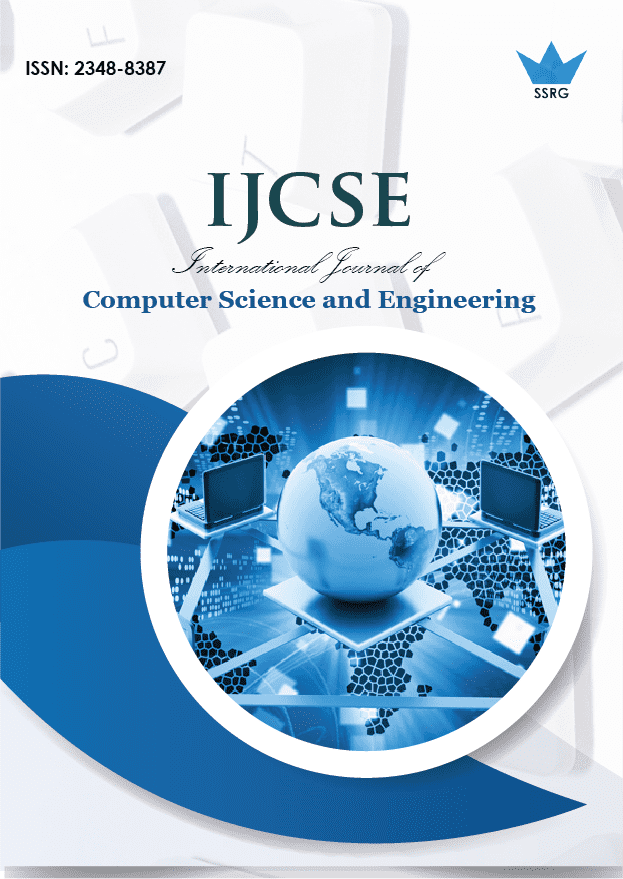Probabilistic Artificial Intelligence for Reliable Decision Making in Edge–Cloud Intelligent Systems

| International Journal of Computer Science and Engineering |
| © 2025 by SSRG - IJCSE Journal |
| Volume 12 Issue 11 |
| Year of Publication : 2025 |
| Authors : Rocky Kumar, Adarsh Kumar Pandey, Gaurav Kumar, Sakshi Sharma |
How to Cite?
Rocky Kumar, Adarsh Kumar Pandey, Gaurav Kumar, Sakshi Sharma, "Probabilistic Artificial Intelligence for Reliable Decision Making in Edge–Cloud Intelligent Systems," SSRG International Journal of Computer Science and Engineering , vol. 12, no. 11, pp. 1-8, 2025. Crossref, https://doi.org/10.14445/23488387/IJCSE-V12I11P101
Abstract:
The increasing integration of Edge-Cloud environments with Artificial Intelligence (AI) has made it possible to process data faster and make decisions in real-time; however, deterministic AI models are not well-suited to manage the uncertainties, and this can be a source of unreliable behavior in dynamic network environments. This paper proposes a framework of Probabilistic Artificial Intelligence to enhance reliability, trust, and explainability in distributed Edge-Cloud intelligent systems. The proposed model applies Bayesian inference and uncertainty quantification techniques to provide confidence levels of AI predictions, which minimizes erroneous decisions in serious applications. The framework incorporates probabilistic reasoning at the edge and cloud layers for adaptive learning, low latency, and efficient resource allocation. Comparative results show that the probabilistic AI model is superior to traditional deterministic methods in terms of accuracy, reliability, and belief in the decision obtained using heterogeneous data collections. The novelty of this study is bringing together probabilistic modeling and Edge-Cloud synergy to increase reliability in intelligent computing systems. The results represent the importance of uncertainty-aware artificial intelligence models in the development of trustworthy and autonomous systems for the next generation of intelligent systems. Novelty in integrating the probabilistic reasoning in an Edge-Cloud architecture. 18-25% improvement in the reliability and 20% reduction in the latency compared to the existing deterministic frameworks.
Keywords:
Bayesian Inference, Edge–Cloud Computing, Intelligent Systems, Probabilistic Artificial Intelligence, Uncertainty Quantification.
References:
[1] Yuyi Mao et al., “A Survey on Mobile Edge Computing: The Communication Perspective,” IEEE Communications Surveys & Tutorials, vol. 19, no. 4, pp. 2322–2358, 2017.
[CrossRef] [Google Scholar] [Publisher Link]
[2] Alex Kendall, and Yarin Gal, “What Uncertainties Do We Need in Bayesian Deep Learning for Computer Vision?,” Advances in Neural Information Processing Systems (NIPS), 2017.
[Google Scholar] [Publisher Link]
[3] David Barber, Bayesian Reasoning and Machine Learning, Cambridge University Press, 2012.
[Google Scholar] [Publisher Link]
[4] Kevin P. Murphy, Probabilistic Machine Learning: An Introduction, MIT Press, 2022.
[Google Scholar] [Publisher Link]
[5] Zhi Zhou et al., “Edge Intelligence: Paving the Last Mile of Artificial Intelligence with Edge Computing,” Proceedings of the IEEE, vol. 107, no. 8, pp. 1738–1762, 2019.
[CrossRef] [Google Scholar] [Publisher Link]
[6] Rui Zheng et al.,, “Uncertainty in Bayesian Deep Label Distribution Learning,” Applied Soft Computing, vol. 101, pp. 1-12, 2021.
[CrossRef] [Google Scholar] [Publisher Link]
[7] L.P. Kaelbling, M.L. Littman, and A.W. Moore, “Reinforcement Learning: A Survey,” Journal of Artificial Intelligence Research, vol. 4, 1996.
[CrossRef] [Google Scholar] [Publisher Link]
[8] Song Han, Huizi Mao, and William J. Dally, “Deep Compression: Compressing Deep Neural Networks with Pruning, Trained Quantization, and Huffman Coding,” International Conference on Learning Representations (ICLR), 2016.
[CrossRef] [Google Scholar] [Publisher Link]
[9] Judea Pearl, Probabilistic Reasoning in Intelligent Systems: Networks of Plausible Inference, Morgan Kaufmann Publishers, 1988.
[Google Scholar] [Publisher Link]
[10] C.E. Rasmussen, and Chris Williams, Gaussian Processes for Machine Learning, MIT Press, 2006.
[Google Scholar] [Publisher Link]
[11] Yarin Gal, “Uncertainty in Deep Learning,” Ph.D. Dissertation, University of Cambridge, 2016.
[Google Scholar] [Publisher Link]
[12] Mahadev Satyanarayanan, “The Emergence of Edge Computing,” Computer, vol. 50, no. 1, pp. 30–39, 2017.
[CrossRef] [Google Scholar] [Publisher Link]
[13] Shiqiang Wang et al., “Adaptive Federated Learning in Resource Constrained Edge Computing Systems,” IEEE Journal on Selected Areas in Communications, vol. 37, no. 6, pp. 1205–1221, 2019.
[CrossRef] [Google Scholar] [Publisher Link]
[14] Nasir Abbas et al., “Mobile Edge Computing: A Survey,” IEEE Internet of Things Journal, vol. 5, no. 1, pp. 450–465, 2018.
[CrossRef] [Google Scholar] [Publisher Link]
[15] Daphne Koller, and Nir Friedman, Probabilistic Graphical Models: Principles and Techniques, MIT Press, 2009.
[Google Scholar] [Publisher Link]
[16] Alex Krizhevsky, Ilya Sutskever, and Geoffrey E. Hinton, “ImageNet Classification with Deep Convolutional Neural Networks,” Advances in Neural Information Processing Systems (NIPS), 2012.
[Google Scholar] [Publisher Link]
[17] Chuan Guo et al., “On Calibration of Modern Neural Networks,” Proceedings of the 34th International Conference on Machine Learning (ICML), pp. 1321–1330, 2017.
[Google Scholar] [Publisher Link]
[18] Alexandru Niculescu-Mizil, and Rich Caruana, “Predicting Good Probabilities with Supervised Learning,” Proceedings of the 22nd International Conference on Machine Learning (ICML), pp. 625–632, 2005.
[CrossRef] [Google Scholar] [Publisher Link]
[19] Mung Chiang, and Tao Zhang, “Fog and IoT: An Overview of Research Opportunities,” IEEE Internet of Things Journal, vol. 3, no. 6, pp. 854–864, 2016.
[CrossRef] [Google Scholar] [Publisher Link]
[20] Finale Doshi-Velez, and Been Kim, “Towards a Rigorous Science of Interpretable Machine Learning,” arXiv preprint arXiv:1702.08608, 2017.
[CrossRef] [Google Scholar] [Publisher Link]
[21] Diederik P. Kingma, Tim Salimans, and Max Welling, “Variational Dropout and the Local Reparameterization Trick,” Advances in Neural Information Processing Systems (NIPS), 2015.
[Google Scholar] [Publisher Link]
[22] Pieter Abbeel, Adam Coates, and Andrew Y. Ng, “Autonomous Helicopter Aerobatics through Apprenticeship Learning,” International Journal of Robotics Research, vol. 29, no. 13, pp. 1608–1639, 2010.
[CrossRef] [Google Scholar] [Publisher Link]
[23] Xu Zhang et al., “Personalized Federated Learning via Variational Bayesian Inference,” Proceedings of the 39th International Conference on Machine Learning, vol. 162, pp. 26293-26310, 2022.
[CrossRef] [Google Scholar] [Publisher Link]
[24] Yarin Gal, and Zoubin Ghahramani, “Dropout as a Bayesian Approximation: Representing Model Uncertainty in Deep Learning,” Proceedings of the 33rd International Conference on Machine Learning, pp. 1050–1059, 2016.
[Google Scholar] [Publisher Link]
[25] Q. Li, X. Huang, and M. Chen, “Federated Deep Learning with Bayesian Privacy,” arXiv preprint, pp. 1-23, 2021.
[CrossRef] [Google Scholar] [Publisher Link]
[26] Giovanni Acampora et al., “Quantum Computing and Artificial Intelligence: Status and Perspectives,” arXiv preprint, pp. 1-33, 2025.
[CrossRef] [Google Scholar] [Publisher Link]
[27] Rajesh Gupta, Dakshita Reebadiya, and Sudeep Tanwar, “6G-Enabled Edge Intelligence for Ultra -Reliable Low Latency Applications: Vision and Mission,” Computer Standards & Interfaces, vol. 77, 2021.
[CrossRef] [Google Scholar] [Publisher Link]
[28] Yuyi Mao et al., “Green Edge AI: A Contemporary Survey,” Proceedings of the IEEE, vol. 112, no. 7, pp. 880-911, 2024.
[CrossRef] [Google Scholar] [Publisher Link]

 10.14445/23488387/IJCSE-V12I11P101
10.14445/23488387/IJCSE-V12I11P101